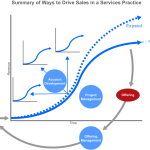When top leaders are informed, thinking critically, and engaged enough to provide guidance and direction, things tend to go pretty well. That is, things get done better, sooner, and more smoothly when leaders pay attention. This note describes an efficient way for top leaders to get and stay up-to-speed, see and understand what is going on, ask questions and think critically, develop a point-of-view, and provide advice and guidance on their organization’s most important functions, projects, and initiatives.
Nearly all of the things that cause activities and initiatives to go off track (see Kotter’s list of eight reasons initiatives fail) could be averted if someone in a position of authority had been involved enough to give guidance along the way. It is hard, though, for leaders to stay sufficiently engaged even in the most important activities and initiatives because it takes time and focused attention that is easily diverted to other urgent matters.
It Pays to Pay Attention
There are a lot of reasons why a given activity or initiative might be considered important. For example, it may be relatively large; risky; involve skills, technology, and methods that are new to the organization; have the potential for great leverage in terms of intellectual property development, revenue generation, cost savings, or skill development. When an activity or initiative is important, it is also important that the effort stays on track, on time, and on-budget!
The best way to ensure on track, on time and on-budget performance are for top leaders to regularly review with those responsible for completing the activity or initiative how things are going. Doing so provides an opportunity for:
- Activity and initiative leaders to step back from the press of day-to-day in order to pull together a consolidated picture of what they are doing to share with others in a safe environment, to challenge their thinking, and to provide advice and counsel on strategy, focus, next steps, and to provide guidance, ideas, and resources that can be brought to bear so as to increase the odds of success.
- Top leaders to stay in touch with what is going on with frontline activity. Any important activity (e.g., delivery, sales, development, marketing, strategic initiatives, etc.) should be reviewed regularly to keep leaders informed about what is going on and for leaders to efficiently provide guidance and direction, consolidate insights across activities, and to drive cross-sharing of resources, insights, and ideas in the best interest of the organization as a whole.
Informal communication on progress is not enough. Neither are occasional one-on-one chats. It is important that those in charge of the function or initiative need to be asked to prepare to brief others on their efforts in a scheduled forum where the activity or initiative is the only agenda. Even better is when others from across and outside the organization with a stake in performance or with relevant past experience and knowledge are also in attendance.
Review Agenda
- what we said we’d do
- what we did
- what happened
- what we learned
what we plan to do next
Leaders set the tone for reviews to ensure that they serve their intended purpose (see: Review POAD) and that they are not done just for the sake of it and to be sure they do not become a “show and tell” exercise. Reviewers must make it safe for those whose work is being discussed to embrace the process and seek input from participants because what is being reviewed is what the organization does and deserves input from the best the organization as to offer.
Leaders ask questions to:
- Draw out clarity
- Give advice
A review is an efficient and smart way for leaders to keep close to what is really going on and to increase the odds that important work gets done well. Reviewers must not look to find fault or assign blame. Instead, they strive to understand what is really going on and to find the best way to improve performance and learn the most.
Reviews also:
- Provide visibility for key staff.
- Create high-stakes circumstances that push up performance.
- Create a forum for executives to model the behavior they want others to emulate.
- Reveal important lessons and insights to share with other teams and initiatives.
Reviews are successful when:
- The Project Manager (PM) and the project team feel:
- They have successfully stepped back from the press of the usual day-to-day to pull together what they are doing into a consolidated whole and shared it with a team of supportive professionals who themselves have reviewed advance materials, showed up, paid attention, participated, and supported the team by challenging its thinking, offering the best advice, and providing access to resources that can be helpful (such as written materials, outside experts, training, and time that will help improve performance).
-
- That the preparation process, the review meeting itself, and the follow-up will help them achieve project objectives better, faster, and more smoothly.
- Management is enlightened with respect to what was reviewed; specifically, what is working, what is not, and what needs to be done and learned as a result
- The organization’s best ideas, thinking, resources, and skills have been brought to bear.
- Participants feel:
- Supported, appreciated, enlightened, engaged, heard, and respected.
- Appropriate next steps have been lined up in the face of the realities and understanding reached.
- The PM understands and internalizes:
- The group’s best thinking in terms of what can be done to most improve performance and/or lower risk and is committed to making that happen
- The top few actions necessary to follow through
- What others will specifically do to support these efforts.
- An open discussion of status leads to the fertilization of ideas across the organization.
- Top leaders collaborate in support of the PM on front-line work.
- The work is completed successfully or it is going so well that reviews are no longer needed to ensure success!
Related Posts
8 Reasons Why Reviews Under-perform
Notes and Tips on how to Run a Great Meeting.
Editor’s note: Updated for 2020, originally posted March 2012.








